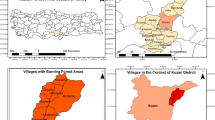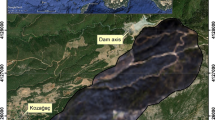Abstract
Fires represents one of the main causes of environmental degradation and have an important negative impact on the landscape. Fires, in fact, strongly influenced ecological processes and compromise the ecosystems. Measurements of the post-fire damage levels over burned areas are important to quantify fire’s impact on landscapes. Remote sensing and geo-statistical approaches are useful tools for the monitoring and analysis of burned areas on a regional scale, because provides reliable and rapid diagnosis of burned areas. Spatial autocorrelation statistics, such as Moran’s I and Getis–Ord Local Gi index, were also used to measure and analyze dependency degree among spectral features of burned areas. This approach improves characterization of a burnt area and improves the estimate of the severity of the fire. This paper provides an application of fire severity studies describing post-fire spectral responses of fire affected vegetation to obtain a burned area map. The aim of this work is to implement a procedure, using ESA Sentinel 2 data and spatial autocorrelation statistics in a GIS open-source environment, a graphical model that analyzes the change detection of the potential burned area, as case of study Northern part of Apulia Region (Italy) was used. The burned area was delineated using the spectral indices calculated using Sentinel two images in the period July–August 2020 and using also the land use map of the area.
Access this chapter
Tax calculation will be finalised at checkout
Purchases are for personal use only
Similar content being viewed by others
References
Atkinson, P.M., Lewis, P.: Geostatistical classification for remote sensing: an introduction. Comput. Geosci. 26.4, 361–371 (2000)
Bar, S., Parida, B.R., Pandey, A.C.: Landsat-8 and Sentinel-2 based Forest fire burn area mapping using machine learning algorithms on GEE cloud platform over Uttarakhand, Western Himalaya. Remote Sens. Appl.: Soc. Environ. 18, 100324 (2020). https://doi.org/10.1016/j.rsase.2020.100324
Bohórquez, L., Gómez, I., Santa, F.: Methodology for the discrimination of areas affected by forest fires using satellite images and spatial statistics. Procedia Environ. Sci. 7, 389–394 (2011)
Copernicus homepage. https://scihub.copernicus.eu/dhus/#/home
Curran, P.J., Atkinson, P.M.: Geostatistics and remote sensing. Prog. Phys. Geogr. 22(1), 61–78 (1998)
Danese, M., Nolè, G., Murgante, B.: Visual impact assessment in urban planning. In: Murgante, B., Borruso, G., Lapucci, A. (eds.) Geocomputation and Urban Planning. Studies in Computational Intelligence, vol. 176. Springer, Berlin, Heidelberg (2009). https://doi.org/10.1007/978-3-540-89930-3_8
de Vasconcelos, S.S., et al.: Variability of vegetation fires with rain and deforestation in Brazil's state of Amazonas. Remote Sens. Environ. 136, 199–209 (2013)
Epting, J., Verbyla, D., Sorbel, B.: Evaluation of remotely sensed indices for assessing burn severity in interior Alaska using Landsat TM and ETM+. Remote Sens. Environ. 96(3–4), 328–339 (2005)
Getis, A., Keith Ord, J.: The analysis of spatial association by use of distance statistics. Perspectives on Spatial Data Analysis, pp. 127–145. Springer, Berlin, Heidelberg (2010). https://doi.org/10.1007/978-3-642-01976-0_10
Gibson, R., Danaher, T., Hehir, W., Collins, L.: A remote sensing approach to mapping fire severity in south-eastern Australia using sentinel 2 and random forest. Remote Sens. Environ. 240, 111702 (2020). https://doi.org/10.1016/j.rse.2020.111702
Giglio, L., Boschetti, L., Roy, D.P., Humber, M.L., Justice, C.O.: The Collection 6 MODIS burned area mapping algorithm and product. Remote Sens. Environ. 217, 72–85 (2018)
Hagolle, O., et al. “A multi-temporal and multi-spectral method to estimate aerosol optical thickness over land, for the atmospheric correction of FormoSat-2, LandSat, VENμS and Sentinel-2 images. Remote Sens. 7.3, 2668–2691 (2015)
Hagolle, O., Huc, M., Villa Pascual, D., Dedieu, G.: A multi-temporal method for cloud detection, applied to FORMOSAT-2, VENµS, LANDSAT and SENTINEL-2 images. Remote Sens. Environ. 114(8), 1747–1755 (2010). https://doi.org/10.1016/j.rse.2010.03.002
Hall, R.J., Freeburn, J.T., de Groot, W.J., Pritchard, J.M., Lynham, T.J., Landry, R.: Remote sensing of burn severity: experience from western Canada boreal fires. Int. J. Wildland Fire 17(4), 476 (2008). https://doi.org/10.1071/WF08013
Illian, J., et al.: Statistical Analysis and Modelling of Spatial Point Patterns. vol. 70. John Wiley & Sons (2008)
ISPRA homepage. http://cartanatura.isprambiente.it/Database/RiferimentiCartografici.php
Key, C.H.: Ecological and sampling constraints on defining landscape fire severity. Fire Ecol. 2(2), 34–59 (2006)
Key, C.: Glacier Field Station Center. Evaluate sensitivities of burn-severity mapping algorithms for different ecosystems and fire histories in the United States (2006)
Lanorte, A., et al.: Multiscale mapping of burn area and severity using multisensor satellite data and spatial autocorrelation analysis. Int. J. Appl. Earth Observ. Geoinf. 20, 42–51 (2013)
Casas, G.L., Scorza, F., Murgante, B.: New urban agenda and open challenges for urban and regional planning. In: Calabrò, F., Spina, L.D., Bevilacqua, C. (eds.) ISHT 2018. SIST, vol. 100, pp. 282–288. Springer, Cham (2019). https://doi.org/10.1007/978-3-319-92099-3_33
Miller, J.D., Thode, A.E.: Quantifying burn severity in a heterogeneous landscape with a relative version of the delta Normalized Burn Ratio (dNBR). Remote Sens. Environ. 109, 66–80 (2007)
Miller, J.D., et al.: Calibration and validation of the relative differenced Normalized Burn Ratio (RdNBR) to three measures of fire severity in the Sierra Nevada and Klamath Mountains, California, USA.“ Remote Sens. Environ. 113.3, 645–656 (2009)
Murgante, B., et al.: A spatial rough set for locating the periurban fringe. SAGEO (2007)
Nolè, G., et al.: Model of Post Fire Erosion Assessment Using RUSLE Method, GIS Tools and ESA Sentinel DATA. In: Gervasi, O., et al. (eds.) ICCSA 2020. LNCS, vol. 12253, pp. 505–516. Springer, Cham (2020). https://doi.org/10.1007/978-3-030-58814-4_36
Nolè, G., Lasaponara, R., Lanorte, A., Murgante, B.: Quantifying Urban Sprawl with spatial autocorrelation techniques using multi-temporal satellite data. Int. J. Agric. Environ. Inf. Syst. 5(2), 19–37 (2014). https://doi.org/10.4018/IJAEIS.2014040102
Rauste, Y., et al. “Satellite-based forest fire detection for fire control in boreal forests. Int. J. Remote Sens. 18.12, 2641–2656 (1997)
Santarsiero, V., et al..: Assessment of Post Fire Soil Erosion with ESA Sentinel-2 Data and RUSLE Method in Apulia Region (Southern Italy). In: Gervasi, O., et al. (eds.) ICCSA 2020. LNCS, vol. 12252, pp. 590–603. Springer, Cham (2020). https://doi.org/10.1007/978-3-030-58811-3_43
Telesca, L., Amatulli, G., Lasaponara, R., Lovallo, M., Santulli, A.: Time-scaling properties in forest-fire sequences observed in Gargano area (southern Italy). Ecol. Model. 185(2–4), 531–544 (2005). https://doi.org/10.1016/j.ecolmodel.2005.01.009
Theia homepage. https://theia.cnes.fr/atdistrib/rocket/#/home
Tobler, W.R.: A computer movie simulating urban growth in the Detroit region. Econ. Geogr. 46(sup1), 234–240 (1970)
van Wagtendonk, J.W., Root, R.R., Key, C.H.: Comparison of AVIRIS and Landsat ETM+ detection capabilities for burn severity. Remote Sens. Environ. 92(3), 397–408 (2004). https://doi.org/10.1016/j.rse.2003.12.015
Xiao, X., Braswell, B., Zhang, Q., Boles, S., Frolking, S., Moore, B.: Sensitivity of vegetation indices to atmospheric aerosols: continental-scale observations in Northern Asia. Remote Sens. Environ. 84(3), 385–392 (2003). https://doi.org/10.1016/S0034-4257(02)00129-3
Author information
Authors and Affiliations
Corresponding author
Editor information
Editors and Affiliations
Rights and permissions
Copyright information
© 2021 Springer Nature Switzerland AG
About this paper
Cite this paper
Santarsiero, V. et al. (2021). A Remote Sensing and Geo-Statistical Approaches to Mapping Burn Areas in Apulia Region (Southern Italy). In: Gervasi, O., et al. Computational Science and Its Applications – ICCSA 2021. ICCSA 2021. Lecture Notes in Computer Science(), vol 12954. Springer, Cham. https://doi.org/10.1007/978-3-030-86979-3_47
Download citation
DOI: https://doi.org/10.1007/978-3-030-86979-3_47
Published:
Publisher Name: Springer, Cham
Print ISBN: 978-3-030-86978-6
Online ISBN: 978-3-030-86979-3
eBook Packages: Computer ScienceComputer Science (R0)





